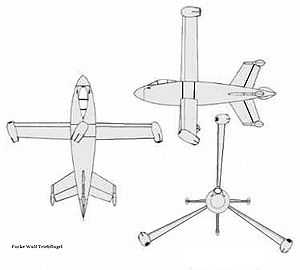Rotor wing
A rotor wing is an aircraft wing which can transition between two lifting modes. For vertical flight and hovering it spins to act as a rotary wing or rotor, and for forward flight at speed it stops to act as a fixed wing.
History
Origins

During World War II Focke-Wulf proposed the Triebflügel, in which the wing as located around the fuselage waist. The proposed mode of operation was to land and take off as a tail-sitter, using the wing as a rotor. The craft would then tilt over to conventional horizontal flight and the wings stop rotating to form two fixed wings with sharp anhedral and a large vertical fin. However during the slowing and stopping of the rotor there would be a phase on at least one blade when the lifting force stopped and then reversed direction. During this phase the craft would have been aerodynamically unstable. This issue was not resolved and the design has never been built.
American interest
Subsequent designs have been configured more like a conventional helicopter, with additional fixed horizontal surfaces to help with stability and control and to provide auxiliary lift.
An early proposal was the conversion of the Lockheed F-104 Starfighter with a triangular rotor wing. The idea was later revisited by Hughes.[1] The Sikorsky S-72 X-wing was rolled out in 1986 but the project was cancelled before it flew.
Canard Rotor/Wing
The canard rotor/wing (CRW) concept adds a "canard" foreplane as well as a conventional tailplane, helping to offload the rotor wing an/or provide control during forward flight. Two prototypes of the Boeing X-50 Dragonfly were constructed and flown from 2003 but the program ended after both had crashed, having failed to transition successfully.[2]
StopRotor Hybrid RotorWing
In 2013 the Naval Research Laboratory (NRL) published a transition method and associated technology, said to be patented, which they call the Stop-Rotor Rotary Wing Aircraft.[3]
The Australian company StopRotor Technology Pty Ltd has developed a prototype Hybrid RotorWing (HRW) craft, based on the US Navy's stop-rotor principle.[4][5] The aircraft's design uses high alpha flight controls to align the relative airflow to the rotational axis of the rotorwing to allow transition between flight modes.[6] During transition the aircraft drops almost vertically, providing a symmetrical airflow across all the rotor blades.
StopRotor Technology launched the idea publicly in April 2013[7] and achieved an inflight transition from fixed to rotary mode in August 2013.[8][9]
See also
References
- ↑ "Hughes Rotor Wing Brochure". The Unwanted Blog (retrieved 15 May 2014)
- ↑ McKenna, James T. "One Step Beyond", Rotor & Wing, February, 2007, page 54
- ↑ "Stop-Rotor Rotary Wing Aircraft". Technology Transfer Office, US Naval Research Laboratory. (retrieved 16 May 2014)
- ↑ "Stoprotor, Hybrid Rotorwing VTOL". sUAS News
- ↑ "Hybrid RotorWing design transitions from fixed to rotary wing mid-flight" gizmag.com
- ↑ "Hybrid RotorWing design transitions from fixed to rotary wing mid-flight". innovationtoronto.com
- ↑ Australian Aviation "Australian company designs new stoprotor aircraft technology", Australian Aviation, 12 April 2013.
- ↑ Rotor & Wing "Hybrid RotorWing Conducts In-flight Fixed/Rotary Transition". Rotor & Wing, 30 August 2013.
- ↑ Australian Aviation "StopRotor completes successful first transition flight". Australian Aviation, 28 August 2013.
External links
|
|